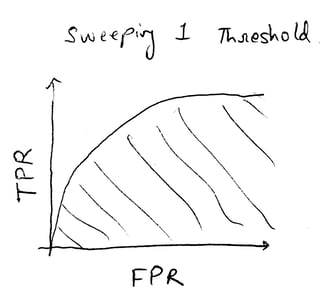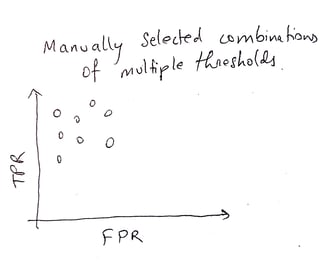Optimal parameter estimation for a classifier with multiple parameters
The image on the left shows a standard ROC curve formed by sweeping a single threshold and recording the corresponding True Positive Rate (TPR) and False Positive Rate (FPR).
The image on the right shows my problem setup where there are 3 parameters, and for each, we have only 2 choices. Together, it produces 8 points as depicted on the graph. In practice, I intend to have thousands of possible combinations of 100s of parameters, but the concept remains the same in this down-scaled case.
I intend to find 2 things here:
- Determine the optimum parameter(s) for the given data
- Provide an overall performance score for all combinations of parameters
In the case of the ROC curve on the left, this is done easily using the following methods:
- Optimal parameter: Maximal difference of TPR and FPR with a cost component (I believe it is called the J-statistic?)
- Overall performance: Area under the curve (the shaded portion in the graph)
However, for my case in the image on the right, I do not know if the methods I have chosen are the standard principled methods that are normally used.
Optimal parameter set: Same maximal difference of TPR and FPR
Parameter score = TPR - FPR * cost_ratio
Overall performance: Average of all "parameter scores"
I have found a lot of reference material for the ROC curve with a single threshold and while there are other techniques available to determine the performance, the ones mentioned in this question is definitely considered a standard approach. I found no such reading material for the scenario presented on the right.
Bottomline, the question here is two-fold: (1) Provide methods to evaluate the optimal parameter set and overall performance in my problem scenario, (2) Provide reference that claims the suggested methods to be a standard approach for the given scenario.
P.S.: I had first posted this question on the "Cross Validated" forum, but didn't get any responses, in fact, got only 7 views in 15 hours.
I'm going to expand a little on aberger's previous answer on a Grid Search. As with any tuning of a model it's best to optimise hyper-parameters using one portion of the data and evaluate those parameters using another proportion of the data, so GridSearchCV is best for this purpose.
First I'll create some data and split it into training and test
import numpy as np
from sklearn import model_selection, ensemble, metrics
np.random.seed(42)
X = np.random.random((5000, 10))
y = np.random.randint(0, 2, 5000)
X_train, X_test, y_train, y_test = model_selection.train_test_split(X, y, test_size=0.3)
This gives us a classification problem, which is what I think you're describing, though the same would apply to regression problems too.
Now it's helpful to think about what parameters you may want to optimise. A cross-validated grid search is a computational expensive process, so the smaller the search space the quicker it gets done. I will show an example for a RandomForestClassifier because it's my go to model.
clf = ensemble.RandomForestClassifier()
parameters = {'n_estimators': [10, 20, 30],
'max_features': [5, 8, 10],
'max_depth': [None, 10, 20]}
So now I have my base estimator and a list of parameters that I want to optimise. Now I just have to think about how I want to evaluate each of the models that I'm going to build. It seems from your question that you're interested in the ROC AUC, so that's what I'll use for this example. Though you can chose from many default metrics in scikit or even define your own.
gs = model_selection.GridSearchCV(clf, param_grid=parameters,
scoring='roc_auc', cv=5)
gs.fit(X_train, y_train)
This will fit a model for all possible combinations of parameters that I have given it, using 5-fold cross-validation evaluate how well those parameters performed using the ROC AUC. Once that's been fit, we can look at the best parameters and pull out the best performing model.
print gs.best_params_
clf = gs.best_estimator_
Outputs:
{'max_features': 5, 'n_estimators': 30, 'max_depth': 20}
Now at this point you may want to retrain your classifier on all of the training data, as currently it's been trained using cross-validation. Some people prefer not to, but I'm a retrainer!
clf.fit(X_train, y_train)
So now we can evaluate how well the model performs on both our training and test set.
print metrics.classification_report(y_train, clf.predict(X_train))
print metrics.classification_report(y_test, clf.predict(X_test))
Outputs:
precision recall f1-score support
0 1.00 1.00 1.00 1707
1 1.00 1.00 1.00 1793
avg / total 1.00 1.00 1.00 3500
precision recall f1-score support
0 0.51 0.46 0.48 780
1 0.47 0.52 0.50 720
avg / total 0.49 0.49 0.49 1500
We can see that this model has overtrained by the poor score on the test set. But this is not surprising as the data is just random noise! Hopefully when performing these methods on data with a signal you will end up with a well-tuned model.
EDIT
This is one of those situations where 'everyone does it' but there's no real clear reference to say this is the best way to do it. I would suggest looking for an example close to the classification problem that you're working on. For example using Google Scholar to search for "grid search" "SVM" "gene expression"
- How can I tell when the model is overfitting?
- StratifiedKFold vs KFold in scikit-learn
- Training a Keras model to identify leap years
- Ideas for Extracting Blade Tip Coordinates from masked Wind Turbine Image
- Macro VS Micro VS Weighted VS Samples F1 Score
- Doing PyWavelets calculation on GPU
- Training loss increases instead of decrease with epochs
- How to save a Dataset in multiple shards using `tf.data.Dataset.save`
- why explain logit as 'unscaled log probabililty' in sotfmax_cross_entropy_with_logits?
- What is the loss function used in Trainer from the Transformers library of Hugging Face?
- Using features extracted using a pretrained CNN as new features for an CNN/NN
- InvalidArgumentError: No DNN in stream executor while training a TensorFlow RetinaNet model on Google Colab
- ALS (Alternating Least Square) algorithm in multiple rankings for a user
- How does one set the pad token correctly (not to eos) during fine-tuning to avoid model not predicting EOS?
- How to create image of confusion matrix in Python
- Cross-validation with nb method
- GPU utilization almost always 0 during training Hugging Face Transformer
- The “Forward/Backward Passage Size” is too large for the pytorch model (Yolov3)
- How many images(minimum) should be there in each classes for training YOLO?
- Why do neural networks work so well?
- Will larger batch size make computation time less in machine learning?
- Why KL divergence is negative in Pytorch?
- Creating a voice identification system using machine learning
- Forward pass with all samples
- override pytorch Dataset efficiently
- fit method in sklearn
- Calibrating Probabilities in lightgbm or XGBoost
- Implementation of F1-score, IOU and Dice Score
- Is it ok to have the training history very similar to the validation history?
- How to understand Shapley value for binary classification problem?

